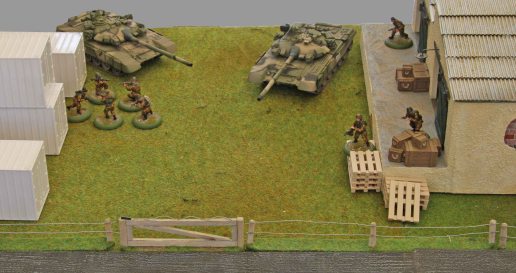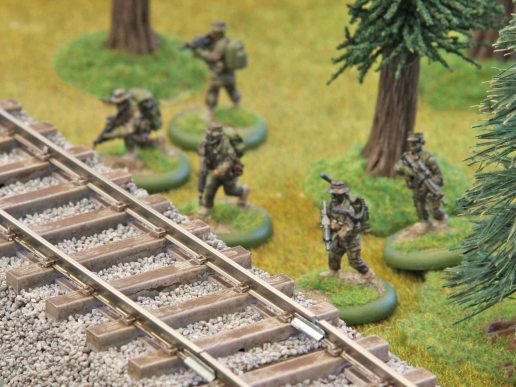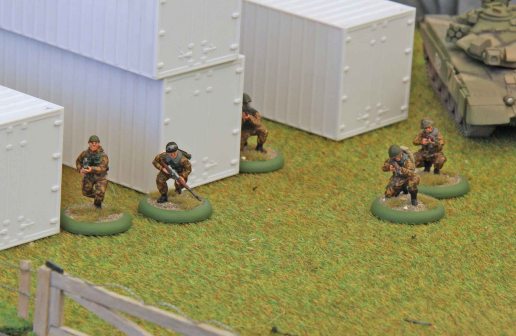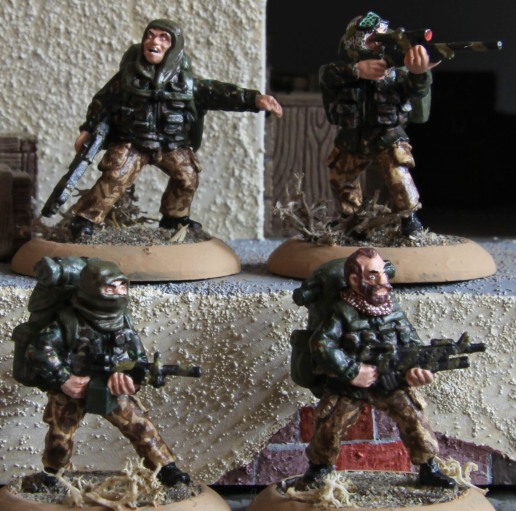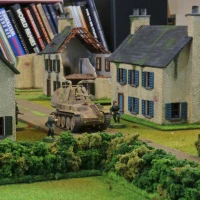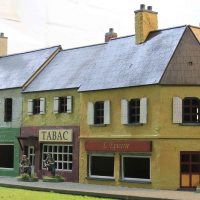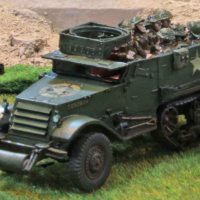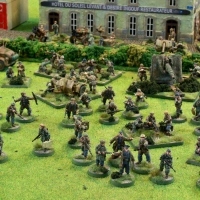For the first time in a very long time we played a modern scenario. Situations was this.
As part of a general attack on western Europe, Russia also decided to return the Baltic Republics to the fold. Not willing to let this happen NATO has decided to send an US Marine Expeditionary Corp to retake Estonia, Latvia and Lithuania. While the initial landings went well against the second and third level units used to garrison Russia’s “acquisitions”, the Marines ran into troubles after a few days when The Russians diverted front line reinforcements to the Baltic, together with a strong anti-aircraft screen.
Against this backdrop, a large USMC Recon patrol stumbles over two Russian T-90 tanks besides a small warehouse. Observations show that the tanks actually are the command tanks for a tank battalion operating in the area. Out of range of the ships heavy artillery and not wanting to risk any of the few fighter aircraft still at his disposal, the expeditionary force commander decides to order the Recon team to attack and take the tankers out before they leave for another attack. But to make matters worse, there is also a Russian infantry detachment to guard the tanks… not an easy nut to crack!
This only being a small skirmish game, we only set up a small table. This was divided at roughly 1/3 of the depth by a raised railroad dam. There was also a road parallel to it. On the other side was a small fenced in warehouse compound with a few containers. The table also featured a small field and some woods. The Russians (eight infantry) set up with-in the compound. Both tank crews were still inside the warehouse where they had spent the night. They would only be allowed to leave it, once the Marines were either spotted or a firefight broke out.The Marines split up into two five men teams that would try to sneak close on each flank. Only the M-60 machine gun would remain behind at the railroad crossing to provide covering fire if need be. At first things went quiet well, with the Marines silently crawling up on their target. But then, having gone roughly half way to their assault position, something went wrong with the team advancing through the woods.
Maybe someone broke a branch or it was the glitter of the sun on a weapon optic, but they were made out by the Russians, who instantly opened up with their LMG. Seeing that things were starting to go south, the M-60 gunner instantly opened up on his Russian counterpart and drove him to cover, but it was already too late… two of the right flank Marines had suffered wounds that turned them incapable to fight on. And now a general firefight broke out between the Marines on the right and the Russians who were starting to scramble to take up defensive positions. In this firefight the Corporal leading the Marines there was killed by a sniper bullet, before the SAW opened up and injured the sniper, taking him out of the fight.
While trying to crawl out from under the M-60s field of fire, one of the Russian NCO´s raised his head a bit too high and received a bullet to the head. At the same time the Russian LMG fired once more, killing another Marines on the right. Plus now the first Russian tankers were leaving the building as well, making for their tanks.
Things were not going well! In this light the Marines on the left gave up their hide. Firing at the Russians closer to the warehouse, they managed to take out the LMG and injure the remaining Russian soldier hiding behind some crates behind by the warehouse. The M-60 ceased its fire and got ready to fire deeper into the compound where the second tank crew had left the building. The remainder of the team split up they. While the recon leader and another of one of his soldiers fired at targets of opportunity, two more soldiers sprinted forward to take the Russians in the flank.
Unfortunately, the first of them came under the sights of the Russians Sergeant who just happened to look around one of the containers. One snapshot and another Marines was down with severe injuries, before the Russian NCO got back behind cover of the containers. The other Marine who had just seen his buddy being felled, got down on his knee and fired his grenade launcher between the containers, eliminating the Russian Sergeant.
Now the remaining Marine on the left flank (the SAW gunner) shifted its fire to the tankers to its front and together with the Marines from the other flank managed to injure or kill four of them. But only to be killed himself by one of the Russians. Now the firefight between the Marines and the three remaining Russians between the containers intensified. While one of the Russians was killed by a bullet, the others withdrew deeper between the containers, only popping around the corners for some snapshots. The devildogs tried their best to get them with more grenades, but had no luck. At the same time the M-60 had managed to take out all of three second tank crew except for one, who managed to get into his tank and close the hatches.
Seeing that the firefight was getting them nowhere, the remaining three Marines charged. When the team leader ran into the first Russian, they got into a bitter hand to combat, which the Marine ended in his favor. Now the sole remaining Russian infantryman surrendered. At first the tanker refused to do the same but being shown the C4 that was about to be attached to his tank, he chose to surrender as well. After blowing up the T-90s, the Marines left with their two prisoners, dead and wounded… too high a price to pay, but still a victory.
![Table set-up [Minis no yet in their starting positions]](https://dhcwargamesblog.files.wordpress.com/2013/05/table-set-up-minis-no-yet-in-their-starting-positions.jpg?w=516&h=255)
